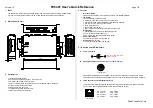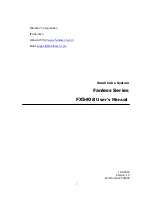
55M4300CCE00 Rev A
Step #19: Attachment “Load adjustment”
This feature is optional and can be omitted if the displayed load is judged acceptable, it
is normally used in tandem with section 3.11 ‘load offset’. A separate load adjustment
calibration is available for each and every jib attachment and is used to improve the
accuracy of the load on hook indication.
The hook weight should not be used alone to judge the load reading performance. This
should be checked using at least 3 different weights, the hook block, 25% SWL, and a
load greater than 50% SWL. The results of these checks should be used to determine
whether “load adjustment”, “load offset” or a combination of both should be used to
improve performance.
“Load adjustment” should only be used if the load reading indicates a constant
percentage load error for the complete operating range, it allows for a positive or
negative percentage value adjustment to be applied to the displayed load. If the error is
variable then verify all data entries required in the dimensions area of the chart file are
correct before proceeding.
It is recommended that this procedure is done with the machine on outriggers or
crawlers.
A known test load is needed to perform this calibration and should be between 50% and
90% of SWL for the configuration to be calibrated. This SWL should be based on the
capacity with a boom angle of approximately 60°.
The calculated test load should normally include the weight of the hook block and any
slings, shackles etc. that are used.
Ensure the current duty selection matches the actual crane configuration to be
calibrated.
1)
Use
“
”
or
“
”
to highlight “Load adjustment” and press
“
”
to enter.
The display will change to show:
Where
Load:
represents the suspended load reading and
1.00
represents the
adjustment factor (a value of 1.00 signifies that there is no applied adjustment). The
main boom should be at an angle of approximately 60°. When positioning the machine
Summary of Contents for i4300
Page 2: ...55M4300CCE00 Rev A ...
















































